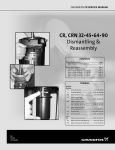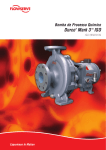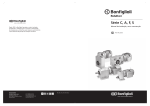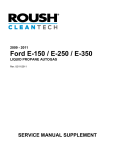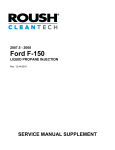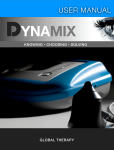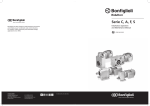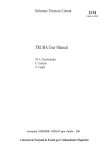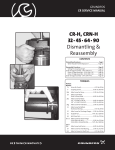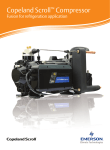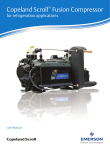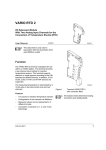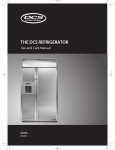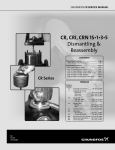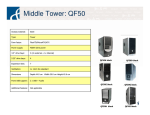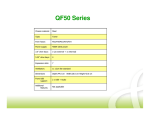Download Installation & Operating Instractions
Transcript
Installation and Operating Instructions QF INSTALLATION AND OPERATING INSTRUCTIONS Page 1. 2. 3. 4. 5. Page DELIVERY AND STORAGE ............................... 2 GENERAL DATA ................................................. 2 PREPARATION ................................................... 3 ELECTRICAL CONNECTION ............................. 6 PUMP INSTALLATION ........................................ 10 6. 7. 8. 9. 10. 1 START-UP AND OPERATION ............................ 11 MAINTENANCE AND SERVICE .........................12 FAULT FINDING CHART .................................... 13 CHECKING OF MOTOR AND CABLE ................ 14 DISPOSAL ..........................................................15 Submersible Pump F+,QF General Data Installation and Operating Instructions If the pump is not handled in vertical position, it must be lifted in the motor part and the pump part at the same time, see fig.2. Note : that the centre of gravity will vary, depending on pump type. IO 01 07 2004 Before beginning installation procedures, these Installation and Operating Instructions should be studied carefully. The installation and operation should also be in accordance with local regulations and accepted codes of good practice. These instructions apply to SHAKTI submersible motors, types 4",6", 8" and SHAKTI submersible pumps, type QF fitted with submersible motors, types SHAKTI FRANKLIN 4"-8", MERCURY 6"-12" and PLEUGER 6"-12". If the pump is fitted with a motor of another motor make than SHAKTI 4",6",8" please note that the motor data may differ from the data stated in these instructions. 1. DELIVERY AND STORAGE Fig. 2 1.1 Delivery SHAKTI submersible pumps are supplied from the factory in proper packing in which they should remain until they are to be installed. During unpacking and prior to installation, care must be taken when handling the pump to ensure that misalignment does not occur due to bending. The loose data plate supplied with the pump should be fixed close to the installation site. The pump should not be exposed to unnecessary impact and shocks. 1.2.1 Frost Protection If the pump has to be stored after use, it must be stored on a frost-free location, or it must be ensured that the motor liquid is frost-proof. 2. GENERAL DATA 2.1 Applications SHAKTI submersible pumps, type QF are manufactured for a wide range of water supply and liquid transfer applications, such as the supply of fresh water to private homes or waterworks, water supply to nursery gardens or farms, draw down of groundwater and pressure boosting, and various industrial jobs. The pump must be installed so that the suction interconnector is completely submerged in the liquid. The pump can be installed either horizontally or vertically, see also section 3.2 Positional Requirements. 1.2 Storage and Handling Storage temperature: Pump : – 20°C to +60°C. Motor : – 20°C to +70°C. The motors must be stored in a closed, dry and well ventilated room. Note : If SHAKTI 4",6", 8" motors are stored for more than one year, the shaft must be turned by hand at least once a month. If a motor has been stored for more than one year before installation, the rotating parts of the motor must be dismantled and checked before use. The pump should not be exposed to direct sunlight. If the pump has been unpacked, it should be stored horizontally, adequately supported, or vertically to prevent misalignment of the pump. Make sure that the pump cannot roll or fall over. During storage, the pump can be supported as shown in fig. 1. 2.2 Pumped Liquids IO 01 07 2004 Clean, thin, non-explosive liquids without solid particles or fibers. The maximum sand content of the water must not exceed 50 g/m3. A larger sand content will reduce the life of the pump and increase the risk of blocking. When pumping liquids with a density higher than that of water, motors with correspondingly higher outputs must be used. Note : If liquids with a viscosity higher than that of water are to be pumped, please contact SHAKTI. The maximum liquid temperature appears from section 3.4 liquid temperature / cooling. Fig. 1 2 Installation and Operating Instructions Submersible Pumps 2.3 Sound Pressure Level 1. Position the submersible pump as shown in fig. 3. The filling screw must be at the highest point of the motor. 2. Remove the screw from the filling hole. 3. Inject liquid into the motor with the filling syringe, fig. 3, until the liquid runs back out of the filling hole. 4. Replace the screw in the filling hole and tighten securely before changing the position of the pump. Torques : The sound pressure level has been measured in accordance with the rules laid down in the EC machinery Directive 98/37/EEC. Sound pressure level of pumps: Applies to pumps submerged in water, without external regulating valve. L pA [dB(A)] QF1 <70 QF2 <70 QF5 <70 QF6 <70 QF12 <70 QF25 <70 QF30 <70 QF50 <70 QF75 <70 QF100 <70 QF125 <70 QF160 <70 QF210 79 QF270 79 QF360 82 4" : 0.5 Nm. The submersible pump is now ready for installation. 4" IO 01 07 2004 Pump Type Fig. 3 3.1.2 SHAKTI Submersible Motors 8" To refill the motor, proceed as follows: 1. Position the submersible pump as shown in fig. 5. 2. Remove the screw (A) from the filling hole and fit the nipple with pipe and funnel supplied with the motor. 3. Remove the air vent screw (B) to allow possible air in the motor to escape. 4. Hold the funnel higher than the vent hole and pour clean water into the motor until the liquid starts dripping out of the motor. 5. Stop pouring water into the motor. Refit the screw (B) to the vent hole and remove pipe and funnel. Replace the screw (A) in the filling hole and tighten securely. The submersible pump is now ready for installation. Sound pressure level of motors: The sound pressure level of SHAKTI 4",6", 8" motors is lower than 70 dB(A). Other motor makes: See installation and operating instructions for these motors. 3. PREPARATION Before starting work on the pump, make sure that the electricity supply has been switched off and that it cannot be accidentally switched on. 3.1 Checking of Liquid in Motor The submersible motors are factory-filled with a special nonpoisonous liquid, which is frost-proof down to –20°C. Note: The level of the liquid in the motor must be checked and the motor must be refilled, if required. Note: If there is a risk of frost, special liquid must be used to refill the motor. Otherwise clean water may be used for refilling (however, never use distilled water). Refilling of liquid is carried out as described below. IO 01 07 2004 3.1.1 SHAKTI Submersible Motors 4",6", 8" The filling hole for motor liquid is placed in the following positions: 4" : in one of the stay bolts. Fig. 5 3 Installation and Operating Instructions Submersible Pumps 3.1.3 SHAKTI 6" & FRANKLIN Submersible Motors from 3.7 kW and up The level of the motor liquid in SHAKTI 6", FRANKLIN 4" and 6" submersible motors is checked by measuring the distance from the bottom plate to the built-in rubber diaphragm. This distance can be measured by inserting a rule or a small rod through the hole until it touches the diaphragm, fig. 6. Note : Take care not to damage the diaphragm. C1 B IO 01 07 2004 A 3.1.4 FRANKLIN Submersible Motors The level of the motor liquid in FRANKLIN 8" submersible motors is checked as follows: • Prise out the filter in front of the valve at the top of the motors using a screwdriver. If the filter is slotted, unscrew. The position of the filling valve is shown in fig. 8. • Press the filling syringe against the valve and inject the liquid, fig. 8. If the valve cone is depressed too far, it may be damaged thus causing the valve to leak. • Remove any air in the motor by pressing the point of the filling syringe lightly against the valve. • Repeat the process of injecting liquid and releasing air until the liquid starts running out or the diaphragm is in its correct position (FRANKLIN 4" and 6"). • Reinstall the filter after refilling with liquid. The submersible pump is now ready for installation. C2 Fig. 6 Motor Dimension Distance SHAKTI 6", 3.7 to 45 kW (see fig. 7c) C1 44 mm FRANKLIN 4", 0.25 to 3 kW (see fig. 7a) A 8 mm IO 01 07 2004 The following table shows the correct distance from the outside of the bottom plate to the diaphragm. Fig. 8 FRANKLIN 4", 3 to 7.5 kW (see fig. 7b) B 16 mm FRANKLIN 6", 4 to 45 kW (see fig. 7c) C1 44 mm FRANKLIN 6", 4 to 22 kW (see fig. 7d) C2 59 mm 7b 7c 7d 3.1.6 PLEUGER Submersible Motors The level of the liquid in the motor is checked as described for FRANKLIN 8" motors, see section 3.1.5 FRANKLIN Submersible Motors. IO 01 07 2004 7a 3.1.5 MERCURY Submersible Motors The level of the liquid in the motor is checked as described for FRANKLIN 8" motors, see section 3.1.5 FRANKLIN Submersible Motors. Fig. 7 If the distance is not correct, carry out an adjustment as described in section 3.1.5 FRANKLIN Submersible Motors. 4 Installation and Operating Instructions Submersible Pumps 3.2 Positional Requirements 3.4 Liquid Temperatures / Cooling If the pump is to be installed in a position where it is accessible, the coupling must be suitably isolated from human touch. The pump can for instance be built into a flow sleeve. Depending on motor type, the pump can be installed either vertically or horizontally. A complete list of motor types suitable for horizontal installation is shown in section 3.2.1. If the pump is installed horizontally, the discharge port should never fall below the horizontal plane, see fig. 9. The maximum liquid temperature and the minimum liquid velocity over the motor appear from the following table. It is recommended to install the motor above the well screen in order to achieve proper motor cooling. Note : In cases where the stated liquid velocity can not be achieved, a flow sleeve must be installed. If there is a risk of sediment build-up, such as sand, around the motor, a flow sleeve should be used in order to ensure proper cooling of the motor. 3.4.1 Maximum Liquid Temperature Out of consideration for the rubber parts in pump and motor, the liquid temperature must not exceed 40°C (~105°F). See also the following table. The pump can operate at liquid temperatures between 40°C and 60°C (~105°F and 140°F) provided that all rubber parts are replaced every third year. IO 01 07 2004 Allowed Not allowed Installation Motor Fig. 9 3.2.1 Motors suitable for horizontal installation Motor type [kW] 4",6", 8" All sizes Vertical Horizontal 0.08 m/s 30°C (~85°F) 30°C (~85°F) SHAKTI 6" 0.16 m/s 30°C (~85°F) 30°C (~85°F) FRANKLIN 4" 0.08 m/s 30°C (~85°F) 30°C (~85°F) FRANKLIN 6" and 8" 0.16 m/s 30°C (~85°F) 30°C (~85°F) MERCURY 0.15 m/s 25°C (~77°F) 25°C (~77°F) PLEUGER 0.5 m/s 30°C (~86°F) 30°C (~86°F) SHAKTI 4" If the pump is installed horizontally, e.g. in a tank, it is recommended to fit it in a flow sleeve. Power output 50 Hz Flow past the motor Power output 60 Hz [kW] All sizes When FRANKLIN 4" submersible motors up to and including 2.2 kW are started more than 10 times a day, it is recommended to incline the motor at least 15° above the horizontal plane in order to minimize wearing of the upthrust disc. Note : During operation, the suction interconnector of the pump must always be completely submerged in the liquid. In special conditions, it may be necessary to submerge the pumpeven deeper, depending on the operating conditions of the actual pump and the NPSH value. Note : If the pump is used for pumping hot liquids (40° to 60°C), care should be taken to ensure that persons cannot come into contact with the pump and the installation, e.g. by installing a guard. Note : By free convection is meant that the borehole diameter is at least 2" larger than the diameter of the submersible motor. Other motor makes: See motor specifications. 3.5 Pipework Connection If noise may be transmitted to the building through the pipework, it is advisable to use plastic pipes. Note : Plastic pipes are recommended for 4" pumps only. When plastic pipes are used, the pump should be secured by an unloaded straining wire. Make sure that the plastic pipes to be used are suitable for the actual liquid temperature and the pump pressure. When connecting plastic pipes, a compression coupling should be used between the pump and the first pipe section. 3.3 Diameter of Pump/Motor The maximum diameter of the pump/motor is as shown in the tables on 16, 17 pages. It is recommended to check the borehole with an inside calliper to ensure unobstructed passage. 5 Installation and Operating Instructions Submersible Pumps 4.2 Motor Protection 4. ELECTRICAL CONNECTION Before starting work on the pump, make sure that the electricity supply has been switched off and that it cannot be accidentally switched on. 4.2.1 Single-Phase Motors Single-phase submersible motors, type 4" must be protected. A protective device can either be incorporated in a control box or separate. FRANKLIN 4" PSC motors must be connected to a motor starter. SHAKTI motors have no built-in temperature transmitter. A Pt100 sensor is available as an accessory. Motors with a Pt100 sensor must be protected by means of: • a motor starter with thermal relay or • contactor(s). Motors without a Pt100 sensor must be protected by means of : • a motor starter with thermal relay or • contactor(s). 4.2.2 Required Motor Starter Settings For cold motors, the tripping time for the motor starter must be less than 10 seconds at 5 times the rated maximum current of the motor. Note: If this requirement is not met, the motor warranty will be invalidated. In order to ensure the optimum protection of the submersible motor, the starter overload unit should be set in accordance with the following guidelines: 1. Set the starter overload to the rated maximum current of the motor. 2. Start the pump and let it run for half an hour at normal performance. 3. Slowly grade down the scale indicator until the motor trip point is reached. 4. Increase the overload setting by 5%. The highest permissible setting is the rated maximum current of the motor. For motors wound for star-delta starting, the starter overload unit should be set as above, but the maximum setting should be as follows: Starter overload setting = Rated maximum current x 0.58. The highest permissible start-up time for star-delta starting or auto trans former starting is 2 seconds. 4.1 General The electrical connection should be carried out by an authorized electrician in accordance with local regulations. The supply voltage, rated maximum current and cosF appear from the loose data plate that must be fitted close to the installation site. The required voltage quality for SHAKTI submersible motors, measured at the motor terminals, is –10%/+6% of the nominal voltage during continuous operation (including variation in the supply voltage and losses in cables). The pump must be earthed. The pump must be connected to an external mains switch. In order that the SHAKTI motors with a built-in and operational temperature transmitter can meet the EC EMC Directive (89/336/EEC), a 0.47 F capacitor (in accordance with IEC 384-14) must always be connected over the two phases to which the temperature transmitter is connected, see fig. 10. 0,47 0.47 µF F 2 3 4 1. Red 2. Yellow 3. Green 4. Blue IO 01 07 2004 1 4.3 Lightning Protection The installation can be fitted with a special over voltage protective device to protect the motor from voltage surges in the electricity supply lines when lightning strikes somewhere in the area, see fig. 11. Fig. 10 The motors are wound for direct-on-line starting or star-delta starting and the starting current is between 4 and 6 times the full load current of the motor. The run-up time of the pump is only about 1 second. Directonline starting is therefore normally approved by the electricity supply authorities. 6 Installation and Operating Instructions L1 L2 L3 PE Submersible Pumps If SHAKTI submersible drop cables are not used, the cross section should be selected on the basis of the current values of the actual cables. Pt. 2 : Note : The cross-section of the submersible drop cable must be large enough to meet the voltage quality requirements specified in section 4.1 General. Determine the voltage drop for the cross-section of the submersible drop cable by means of the diagrams I = Rated maximum current of the motor. For star-delta starting I=rated maximum current of the motor x 0.58. Lx= Length of cable converted to a voltage drop of 1% of the nominal voltage. Lx = length of drop cable Three-Phase Single-Phase IO 01 07 2004 L N PE Fig. 11 The over voltage protective device will not, however, protect the motor against a direct stroke of lightning. The over voltage protective device should be connected to the installation as close as possible to the motor and always in accordance with local regulations. Ask SHAKTI for lightning protective devices. permissible voltage drop in % q = Cross-section of submersible drop cable. Draw a straight line between the actual I-value and the Lxvalue. Where the line intersects the q-axis, select the crosssection that lies right above the intersection. The diagrams are made on the basis of the formulas: Single-phase submersible motor: 4.4 Cable Sizing Make sure that the submersible drop cable can withstand permanent submersion in the actual liquid and at the actual temperature. SHAKTI can supply submersible drop cables for a wide range of installations. The cross-section (q) of the cable should meet the following requirements: 1. The submersible drop cable should be dimensioned to the rated maximum current (I) of the motor. 2. The cross-section should be sufficient to make a voltage drop over the cable acceptable. Use the largest of the cross sections found under points 1. and 2. Pt. 1 : The following table specifies the current value of SHAKTI submersible drop cables (i.e. the maximum current tolerated by the drop cable) at an ambient temperature of maximum 30°C. Please contact SHAKTI if the ambient temperature lies above 30°C. When sizing the submersible drop cable, make sure that the rated maximum current does not exceed the current value (Is). For star-delta starting, however, size the cables so that 0.58 x the rated maximum current of the motor does not exceed the current value (Is) of the cables. q [mm ²] Is [A] 1.5 14 2.5 18 4 24 6 30 10 39 16 55 25 66 35 77 L = UxDU I x 2 x 100 x (cosj x P sinj Xl) q Three-phase submersible motor: L = UxDU I x 1.73 x 100 x (cosj x P sinj Xl) q where L = Length of submersible drop cable [m] U = Nominal voltage [V] DU = Voltage drop [%] I = Rated maximum current of the motor [A] cosj = 0.9 p = Specific resistance: 0.02 [Wmm2/m] q = Cross-section of submersible drop cable [mm2] sinj = 0.436 Xl = Inductive resistance: 0.078 x 10-3 [W/m] 4.5 Control of Single-Phase Motors The single-phase submersible motor with protection(saprate) which cuts out the motor in case of excessive winding temperatures while the motor is still supplied with voltage. Allow for this, when the motor forms part of a control system. If a compressor is included in a control system together with an ochre filter, the compressor will run continuously once the motor protection has cut out the motor, unless other special precautions have been taken. 7 Installation and Operating Instructions Submersible Pumps 4.6 Connection of Single-Phase Motors 4.6.3 3 - Wire Motors SHAKTI 3-wire motors should be connected to the mains via a control box. The connection of MCI 100 motors appears from the following table: 4.6.1 PSC Motors The SHAKTI 4" motors are connected to the mains via an operating capacitor which should be dimensioned for continuous operation. Select the correct capacitor size from the following table: Motor Motor Cable Up to 0.37 kW Red Blue Yellow Green Capacitor 0.37 kW 16 m F / 400 V / 50 Hz 0.55 kW 20 m F / 400 V / 50 Hz 0.75 kW 30 m F / 400 V / 50 Hz 1.10 kW 40 m F / 400 V / 50 Hz 1.50 kW 50 m F / 400 V / 50 Hz 2.20 kW 75 m F / 400 V / 50 Hz IO 01 07 2004 Red Yellow Blue Green Fig. 13 4.6.2 The FRANKLIN 4" PSC motor should be connected to the mains via the motor protection, see fig. 14. L L P L 3 PE 4.7.1 Checking of Direction of Rotation Note : The pump must not be started until the suction interconnector has been completely submerged in the liquid. When the pump has been connected to the electricity supply, determine the correct direction of rotation as follows: 1. Start the pump and check the quantity of water and head developed. 2. Stop the pump and interchange two of the phase connections. In the case of motors wound for star-delta starting, exchange lead wire. 3. Start the pump and check the quantity of water and head developed. 4. Stop the pump. Compare the results taken under points 1. and 3. The connection which gives the larger quantity of water and the higher head is the correct connection. C M P 2 Three-phase submersible motors must be protected, see section 4.2.2 Three-Phase Motors. When a conventional motor starter is being used, the electrical connection should be carried out as described below. L 1 1 Mains 4.7 Connection of Three-Phase Motors The SHAKTI 4" motor incorporates motor protection and should be connected to the mains as shown in fig. 13. N Control Box 4.7.2 SHAKTI Motors, Direct-On-Line Starting The connection of SHAKTI submersible motors wound for direct-on-line starting appears from the following table and fig. 15. N Cable/Connection Mains L1 1 Fig. 14 IO 01 07 2004 M Black Brown C Blue Yellow/green SHAKTI 4" and 6" Motors R L2 Y L3 B PE PE Check the direction of rotation as described in section 4.7.1 Checking of Direction of Rotation. 8 Installation and Operating Instructions Submersible Pumps 4.7.4 Connection in the Case of Unidentified Cable Marking / Connection If it is unknown where the individual leads are to be connected to the mains in order to ensure the correct direction of rotation, proceed as follows : Motors wound for direct-on-line starting : Connect the pump to the mains as is expected to be right. Then check the direction of rotation as described in section 4.7.1 Checking of Direction of Rotation. Motors wound for star-delta starting : The windings of the motor are determined by means of an ohmmeter, and the lead sets for the individual windings are named accordingly, see fig. 18. R Y B PE M 3 IO 01 07 2004 L1 L2 L3 PE Fig. 15 4.7.3 SHAKTI Motors, Star-Delta Starting The connection of SHAKTI submersible motors wound for star-delta starting appears from the following table and fig.16. Check the direction of rotation as described in section 4.7.1 Checking of Direction of Rotation. R1 R2 Y1 Y2 B1 B2 IO 01 07 2004 R1 R2 Y1 Y2 B1 B2 L1 L2 L3 PE Fig. 18 If star-delta starting is required, the leads should be connected as shown in fig. 16. If direct-on-line starting is required, the leads should be connected as shown in fig. 17. Then check the direction of rotation as described in section 4.7.1 Checking of Direction of Rotation. V1 W1 PE M 3 IO 01 07 2004 B2 R2 Y2 U1 Fig. 16 4.7.5 FRANKLIN, MERCURY and PLEUGER Motors The connection of FRANKLIN, MERCURY and PLEUGER motors appears from section 4.7.4 Connection in the Case of Unidentified Cable Marking/Connection. If star-delta starting is not required, but direct-on-line starting is, the submersible motors should be connected as shown in fig. 17. L1 L2 L3 PE V1 W1 PE M 3 IO 01 07 2004 B2 R2 Y2 U1 Fig. 17 9 Installation and Operating Instructions Submersible Pumps 5. PUMP INSTALLATION 5.4 Riser Pipe If a tool, e.g. a chain pipe wrench, is used when the riser pipe is fitted to the pump, the pump must only be gripped by the pump discharge chamber. The threaded joints on the riser pipe must all be well cut and fit together to ensure that they do not work loose when subjected to torque reaction caused by the starting and stopping of the pump. The thread on the first section of the riser pipe which is to be screwed into the pump should not be longer than the threads in the pump. If noise may be transmitted to the building through the pipework, it is advisable to use plastic pipes. Note: Plastic pipes are recommended for 4" pumps only. When plastic pipes are used, the pump should be secured by an unloaded straining wire to be fastened to the discharge chamber of the pump, see fig. 19. Before starting any work on the pump/motor, make sure that the electricity supply has been switched off and that it cannot be accidentally switched on. 5.1 Assembly of Motor and Pump The bolts and nuts securing the straps to the pump must be tightened diagonally to the torques stated in the following table: Straps Bolt/Nut Torque [Nm] M8 18 M10 35 M12 45 M16 110 QF360, 50 Hz, with more than 8 stages QF360, 60 Hz, with more than 5 stages 135 Make sure that the coupling between the pump and motor engages properly. When assembling the motor and the pump, the nuts must be tightened diagonally to the torques stated in the following table: Torque [Nm] M8 18 M12 100 M16 200 M20 390 IO 01 07 2004 Pump/Motor Staybolt Diameter Fig. 19 When connecting plastic pipes, a compression coupling should be used between the pump and the first pipe section. Where flanged pipes are used, the flanges should be slotted to take the submersible drop cable and a water indicator hose, if fitted. Note : Make sure that the pump chambers are aligned when assembly has been completed. 5.2 Removal and Fitting of Cable Guard For removal and fitting of cable guard(s), see last pages. If the cable guard is screwed on to the pump, such as the QF360 and sleeved pumps, the cable guard should be removed and fitted by means of screws. Note : Make sure that the pump chambers are aligned when the cable guard has been fitted. SHAKTI motors 5.5 Maximum Installation Depth below Water Level : 350 m. FRANKLIN motors : 350 m. MERCURY motors : 350 m. 5.3 Fitting of Submersible Drop Cable PLEUGER motors 350 m. 5.3.1 SHAKTI Submersible Motors Before fitting the submersible drop cable to the motor, make sure that the cable socket is clean and dry. To facilitate the fitting of the cable, lubricate the rubber parts of the cable plug with non-conducting silicone paste. Tighten the screws holding the cable to the torques stated: 4" : 1.5 Nm. 6' : 4.0-5.0 Nm. 8" : 15 Nm. 5.6 Cable Fitting : Cable clips must be fitted every 3 meters to fix the submersible drop cable and the straining wire, if fitted, to the riser pipe of the pump. Cable Fitting: Cut off the rubber band so that the piece with no slit becomes as long as possible. Insert a button in the first slit. Position the wire alongside the submersible drop cable, fig.20. 10 Installation and Operating Instructions Submersible Pumps 6. START-UP AND OPERATION 6.1 Start-Up IO 01 07 2004 When the pump has been connected correctly and it is submerged in the liquid to be pumped, it should be started with the discharge valve closed off to approx. 1/3 of its maximum volume of water. Check the direction of rotation as described in section 4.7.1 Checking of Direction of Rotation. If there are impurities in the water, the valve should be opened gradually as the water becomes clearer. The pump should not be stopped until the water is completely clean, as otherwise the pump parts and the non-return valve may choke up. As the valve is being opened, the drawdown of the water level should be checked to ensure that the pump always remains submerged. The dynamic water level should always be above the suction interconnector of the pump, see section 3.2 Positional Requirements and fig. 21. Wind the band once around the wire and the cable. Then wind it tightly at least twice around the pipe, wire and the cable. Push the slit over the button and then cut off the band. Where large cable cross-sections are used, it will be necessary to wind the band several times. Where plastic pipes are used, some slackness must be left between each cable clip as plastic pipes expand when loaded. When flanged pipes are used, the cable clips should be fitted above and below each joint. L2 L3 5.7 Lowering the Pump L4 It is recommended to check the borehole by means of an inside calliper before lowering the pump to ensure unobstructed passage. Lower the pump carefully into the borehole, taking care not to damage the motor cable and the submersible drop cable. TM00 1368 2298 TM00 1369 5092 Note : Do not lower or lift the pump by means of the motor cable. L5 5.8 Installation Depth Fig. 21 The dynamic water level should always be above the suction interconnect or of the pump, see section 3.2 Positional Requirements and fig. 21. Minimum inlet pressure is indicated in the NPSH curve for the pump. The minimum safety margin should be 1 metre head. It is recommended to install the pump so that the motor part is above the well screen in order to ensure optimum cooling, see section 3.4 Liquid Temperatures/Cooling. When the pump has been installed to the required depth, the installation should be finished by means of a borehole seal. Slacken the straining wire so that it becomes unloaded and lock it to the borehole seal by means of wire locks. For pumps fitted with plastic pipes, the expansion of the pipes when loaded should be taken into consideration, when deciding on the installation depth of the pump. IO 01 07 2004 L1 L1 : Minimum installation depth below dynamic water level. Minimum 1 metre is recommended. L2 : Depth to dynamic water level. L3 : Depth to static water level. L4 : Draw down. This is the difference between the dynamic and the static water levels. L5 : Installation depth. If the pump can pump more than yielded by the well, it is recommended to fit the control unit, or some other type of dry-running protection. If no water level electrodes or level switches are installed, the water level may be drawn down to the suction interconnector of the pump and the pump will then draw in air. Long time operation with water containing air may damage the pump and cause insufficient cooling of the motor. 11 Installation and Operating Instructions Submersible Pumps 6.2 OPERATION 6.2. 1 Minimum Flow Rate To ensure the necessary cooling of the motor, the pump should never be set so low that the cooling requirements specified in section 3.4 Liquid Temperatures/Cooling cannot be met. 6.2.2 Frequency of Starts and Stops SHAKTI MOTOR Minimum 1 per year is recommended. Maximum 100 per day. FRANKLIN Minimum 1 per year is recommended. Maximum 100 per day. MERCURY 6" Minimum 1 per year is recommended. Maximum 20 per hour. MERCURY 8" Minimum 1 per year is recommended. Maximum 15 per hour. MERCURY 10" Minimum 1 per year is recommended. Maximum 10 per hour. MERCURY 12" Minimum 1 per year is recommended. Maximum 6 per hour. PLEUGER Minimum 1 per year is recommended. Maximum 100 per day. 7. MAINTENANCE AND SERVICE The pumps are maintenance-free. All pumps are easy to service. Service kits and service tools are available from SHAKTI. The SHAKTI Service Manual is available on request. The pumps can be serviced at a SHAKTI service centre or authorised. If a pump has been used for a liquid which is injurious to health or toxic, the pump will be classified as contaminated. If SHAKTI is requested to service the pump, SHAKTI must be contacted with details about the pumped liquid, etc. before the pump is returned for service. Otherwise SHAKTI can refuse to accept the pump for service. Possible costs of returning the pump are paid by the customer. 12 Installation and Operating Instructions Submersible Pumps 8. FAULT FINDING CHART Fault 1. The pump does not run. Remedy Cause a) The fuses are blown. Replace the blown fuses. If the new ones blow too, the electric installation and the submersible drop cable should be checked. Cut in the circuit breaker. b) The ELCB or the voltage-operated ELCB has tripped out. c) No electricity supply. Contact the electricity supply authorities. d) The motor starter overload has tripped out. Reset the motor starter overload (automatically or possibly manually). If it trips out again, check the voltage.Is the voltage OK, see items e) - h). e) Motor starter/contactor is defective. Replace the motor starter/contactor. f) Starter device is defective. Repair/replace the starter device. g) The control circuit has been interrupted or Check the electric installation. is defective. h) The dry-running protection has cut off the Check the water level. If it is OK, check the water the electricity supply to the pump, due to level electrodes/level switch. low water level. i) The pump/submersible drop cable is Repair/replace the pump/cable. defective. 2. The pump runs but gives no water. 3. The pump runs at reduced capacity. a) The discharge valve is closed. b) No water or too low water level in borehole. c) The non-return valve is stuck in its shut position. d) The inlet strainer is choked up. e) The pump is defective. a) The draw down is larger than anticipated. b) c) d) e) f) 4. Frequent starts and stops. g) h) i) a) Open the valve. See item 3 a). Pull out the pump and clean or replace the valve. Pull out the pump and clean the strainer. Repair/replace the pump. Increase the installation depth of the pump, throttle the pump or replace it by a smaller model to obtain a smaller capacity. Wrong direction of rotation. See section 4.7.1 Checking of Direction of Rotation. The valves in the discharge pipe are partly Check and clean/replace the valves, if necessary. closed/blocked. The discharge pipe is partly choked by Clean/replace the discharge pipe. impurities (ochre). The non-return valve of the pump is partly Pull out the pump and check/replace the valve. blocked. The pump and the riser pipe are partly Pull out the pump. Check and clean or replace the choked by impurities (ochre). pump, if necessary. Clean the pipes. The pump is defective. Repair/replace the pump. Leakage in the pipework. Check and repair the pipework. The riser pipe is defective. Replace the riser pipe. The differential of the pressure switch Increase the differential. However, the stop between the start and stop pressures is pressure must not exceed the operating pressure too small. of the pressure tank, and the start pressure should be high enough to ensure sufficient water supply. 13 Installation and Operating Instructions Fault Submersible Pumps Remedy Cause b) The water level electrodes or level switches in the reservoir have not been installed correctly. c) The non-return valve is leaking or stuck half-open. d) The volume of air in the pressure / diaphragm tank is too small. e) The pressure/diaphragm tank is too small. f) The diaphragm of the diaphragm tank is defective. Adjust the intervals of the electrodes / level switches to ensure suitable time between the cutting-in and cutting-out of the pump. See Installation and Operating Instructions for the automatic devices used. If the intervals between stop/start cannot be changed via the automatics, the pump capacity may be reduced by throttling the discharge valve. Pull out the pump and clean/replace the non-return valve. Adjust the volume of air in the pressure/diaphragm tank in accordance with its Installation and Operating Instructions. Increase the capacity of the pressure / diaphragm tank by replacing or supplementing with another tank. Check the diaphragm tank. 9. CHECKING OF MOTOR AND CABLE 1. Supply voltage Measure the voltage between the phases by means of a voltmeter. On single-phase motors, measure between phase and neutral or between two phases, depending on the type of supply. Connect the voltmeter to the terminals in the motor starter. The voltage should, when the motor is loaded, be within the range specified in section 4.1 General. The motor may burn if there are larger variations in voltage. Large variations in voltage indicate poor electricity supply, and the pump should be stopped until the defect has been remedied. 2. Current consumption Measure the amps of each phase while the pump is operating at a constant discharge head (if possible, at the capacity where the motor is most heavily loaded). For maximum operating current, see nameplate. On three-phase motors, the difference between the current in the phase with the highest consumption and the current in the phase with the lowest consumption should not exceed 5%. If so, or if the current exceeds the full load current, there are the following possible faults : • The contacts of the motor starter burnt. Replace the contacts or the control box for single-phase operation. • Poor connection in leads, possibly in the cable joint. See item 3. • Too high or too low supply voltage. See item 1. • The motor windings are short-circuited or partly disjointed. See item 3. 14 Installation and Operating Instructions Submersible Pumps • Damaged pump is causing the motor to be overloaded. Pull out the pump for overhaul. • The resistance value of the motor windings deviates too much (three-phase). Move the phases in phase order to a more uniform load. If this does not help, see item 3. Items 3 and 4: Measurement is not necessary when the supply voltage and the current consumption are normal. 3. Winding resistance Disconnect the submersible drop cable at the motor starter. Measure the winding resistance between the leads of the drop cable. For three-phase motors, the deviation between the highest and the lowest value should not exceed 5%. If the deviation is higher, pull out the pump. Measure motor, motor cable and drop cable separately, and repair/replace defective parts. Note : On single-phase, 3-wire motors, the operating winding will assume the lowest resistance value. 4. Insulation resistance Disconnect the submersible drop cable at the motor starter. Measure the insulation resistance from each phase to earth (frame). Make sure that the earth connection is made carefully. If the insulation resistance is less than 0.5 M, the pump should be pulled out for motor or cable repair. Local regulations may specify other values for the insulation resistance. 10. DISPOSAL Disposal of this product or parts of it must be carried out according to the following guidelines: 1. Use the local public or private waste collection service. 2. In case such waste collection service does not exist or cannot handle the materials used in the product, please deliver the product or any hazardous materials from it to your nearest SHAKTI company representative or service workshop. 15 Installation and Operating Instructions Pump Submersible Pumps Maximum Diameter of Pump/Motor [mm] Motor Type Thread Flange Direct-On-Line Starting 4" QF1 QF2 QF5 QF6 QF12 Rp 1¼ 101 Rp 1¼ 101 *R 1¼ 108 Rp 1¼ 101 Rp 1½ 101 138 101 138 *R 1½ *R 2 Rp 2 101 Rp 2 131 131 QF75 Rp 2½ QF125 QF160 QF210 QF270 QF360 Star-Delta Starting 12" *R 3 140 6" 8" 10" 12" 143 140 143 169 192 175 192 137 143 192 147 192 Rp 3 141 145 192 150 192 Rp 4 145 147 192 153 Rp 3 *R 3 192 *R 4 QF100 10" 140 F10+ QF50 8" 138 Rp 2 QF25 QF30 6" 192 192 192 192 Rp 3 141 145 Rp 4 145 147 192 153 192 178 197 186 205 200 200 200 205 178 197 186 205 208 208 212 212 211 218 218 232 222 230 226 239 211 218 218 227 211 218 218 227 241 241 248 286 247 247 259 286 241 241 248 286 247 247 259 286 Rp 5 5" Rp 5 5" Rp 6 6" Rp 6 6" Rp 6 6" 150 * Pump in sleeve 16 Installation and Operating Instructions Side 126 Pump Submersible Pumps Maximum Diameter of Pump/Motor [mm] Motor Type Thread Flange QF1 Rp 1¼ 125 Rp 1¼ 125 Pump in Flow Sleeve 4" QF2 QF5 QF6 R 1¼ 125 Rp 1 ¼ 125 Rp 1½ 125 QF25 QF30 QF75 125 200 R2 200 Rp 2 125 Rp 2½ 200 200 R3 200 200 200 R3 200 200 Rp 4 200 200 250 250 250 250 Rp 3 200 200 Rp 4 200 200 250 250 250 250 250 250 250 250 250 280 280 280 280 280 280 280 280 355 355 355 355 Rp 5 5" Rp 5 QF160 5" Rp 6 QF210 6" Rp 6 QF270 6" Rp 6 QF360 250 250 Rp 3 QF125 12" 200 R4 QF100 10" 200 Rp 3 QF50 8" 200 R 1½ Rp 2 QF12 6" 6" 17 355 355 355 18 L - = ----------120- = 60 m = q Lx = ------U 2 U = 3 x 380 V I = 10 A L = 120 m U = 2% 6 mm2 Example: L = 120 m I = 10 A U = 2% U = 3 x 380 V L - = ----------140- = 70 m = q Lx = ------U 2 U = 3 x 400 V I = 40 A L = 140 m U = 2% 25 mm2 Example: L = 140 m I = 40 A U = 2% U = 3 x 400 V Installation and Operating Instructions Submersible Pumps ide 127Side 128 19 L - = ----------150- = 50 m = q Lx = ------3 U U = 3 x 415 V I = 100 A L = 150 m U = 3% 50 mm2 Example: L = 150 m I = 100 A U = 3% U = 3 x 415 V L - = ----------105- = 35 m = q Lx = ------3 U U = 3 x 220 V I =5A L = 105 m U = 3% 2 ,5 mm2 Example: L = 105 m I=5A U = 3% U = 3 x 220 V Installation and Operating Instructions Submersible Pumps Installation and Operating Instructions Submersible Pumps QF1,2,5,6, 12, 25 Fig. 1 Fig. 1 Fig. 2 Fig. 3 Fig. 2 Fig. 3 QF1,2,5,6, 12, 25 Fig. 2 Fig. 1 Fig. 2 Fig. 1 20 Installation and Operating Instructions Submersible Pumps QF30 - QF50 - QF75 - QF100 Fig. 1 Fig. 2 Fig. 3 Fig. 1 Fig. 2 Fig. 3 QF125 - QF160 - QF210 - QF270 - QF360 Fig. 1 Fig. 1 Fig. 2 Fig. 3 Fig. 2 Fig. 3 21 Declaration of Conformity We SHAKTI PUMPS (INDIA) LIMITED declare under our sole responsibility that the products QF, & Electrical motor 4", 6", 8",10" model to which this declaration relates, are in conformity with the Council Directives on the approximation of the laws of the EEC Member States relating to following standard and technical specification: Machinery Directive (98/37/EEC). Standard used: EN 292. Electromagnetic compatibility (89/336/EEC). Standards used: EN 61 000-6-2 and EN 61 000-6-3. Electrical equipment designed for use within certain voltage limits, as per low voltage Directive (73/23/EEC). Standards used: EN 60 335-1 and EN 60 335-2-41. And are in conformity with: IS: 9283,IS: 8034 NAME: AJAY PATIDAR J. UPADHYAY POSITION: MANAGER QUALITY DEPARTMENT HEAD PRODUCT ENGINEERING DATE: 15.07.2004 SIGNED: From: QD 15720004 rev. 00






















